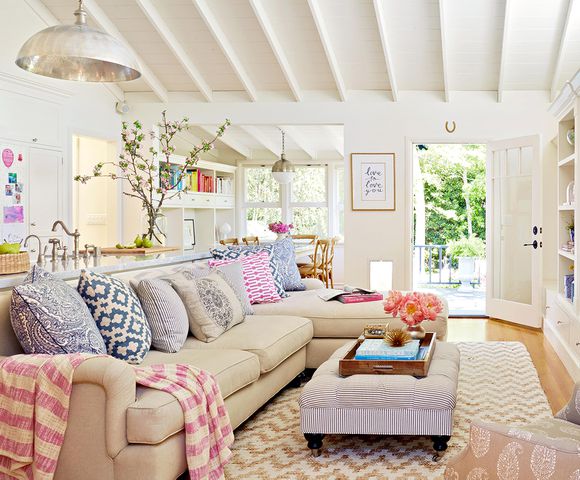How to Choose Interior Color Schemes You’ll Love
The following tips on choosing an interior color scheme will help you fill rooms with shades that beautifully reflect your personal style.
How to Choose an Interior Color Scheme
When planning a room’s color scheme, resist the temptation to select the paint color first. Instead, because paint is inexpensive and can be matched to virtually any color, it’s best to start your color search with room elements that are less flexible, such as furniture, fabrics, tile, or wallpaper. Then base your paint colors on those elements. Here are some ideas on how to narrow down your color choices.
1. Find Inspiration for Your Color Scheme
For an easy way to create a color scheme, base your choices on an image or item you love. This could be a piece of artwork, an area rug, a photo you saw online, or a patterned fabric that appeals to you. Pull out specific shades within the design and apply them to your decorating choices. Pay attention to the proportions of each shade to recreate a similarly balanced interior color scheme.
2. Consider Color Value
As you choose colors, don’t forget to consider the value, which refers to the lightness or darkness of a hue. A mix of values within your color scheme helps to keep a multi-hue palette from looking chaotic. Try selecting one dark color, one light color, and one bright color in each room. The color that acts as the room’s dominant hue depends on your preference. “Go for your comfort level,” says Mark Woodman, interior designer and board member of the Color Marketing Group. “Choose clean and bright or soft and subtle.”
3. Plan Your Home’s Color Scheme
If you’re wary of color, map it out first. Draw a plan of your home and list what will be in each room, such as the carpet, wall colors, and furniture. Gather swatches or paint chips that represent the colors of those items. Assess the spaces for both positive and negative attributes; write them down. Find focal points from the list of positive traits.
You should also consider how one room will flow into the next, what mood you want, and the items to be incorporated into the palette. Plan the house one room at a time. For an easy whole-home color palette, try using one color in different proportions in all rooms: as a wall color in one room and accent in another.
4. Consider How Light Affects Colors
Pay attention to the impact of lighting. Color is a reflection of light, so the kind and amount of light in a room will significantly impact a color scheme. Experiment with how natural light or light from lamps and recessed fixtures affects color in fabrics, paint, furniture, and other surfaces.
Daylight is considered the perfect light source because it has nearly uniform intensity over the entire visible spectrum of colors. Natural light changes from sunrise to sunset as the sun’s rays travel through varying amounts of atmosphere.
When considering a color scheme for a particular room, spend some time in the space throughout the day, noting how the shifting light affects it. For example, a room with only northern exposure receives less daylight than other rooms in the home. A warm color palette would be effective in softening shadows and react well to more hours of artificial light in a room like that.
Incandescent lamps emit a redder and warmer light than sunlight. Fluorescent lamps, on the other hand, generally create a bluer, cooler light. When selecting colors for a room that is used primarily before sunrise or after sunset, choose the colors only under the lighting used in the room. Keep in mind that any color with white in it will reflect the colors that surround it. A white wall, for example, will take on the reflections from carpeting, ceiling color, and even furnishings.
How to Apply Your Interior Color Scheme
Adding color to a room doesn’t have to mean a long-term relationship with a chosen hue. If you prefer a neutral background, there are many ways to add color with small touches or bursts of a selected color scheme. Fabrics and textiles such as rugs, pillows, throws and window treatments are the perfect elements for inviting color in and can add pattern and texture as well.
Artwork brings in color and personality at the same time. Accessories and personal collections can act as colorful accents in your room. And don’t forget the lively hues of natural elements like flowers and fruit. Grouped in vases or bowls, they create a colorful mass in any space.
While neutrals might seem safe, there are many benefits to using color in your home. Color can unite disparate furnishings styles and works well for renewing worn or outdated furniture. A fresh, unexpected pop of color can turn a dull room into a stylish, personalized space. Using color can also manipulate your sense of space. A small room can seem larger with light colors; a large room will shrink with a darker shade on the walls. You can visually lower a ceiling with a dark color and raise it with a light one.
This article was written by Jessica Bennett from Better Homes and Gardens and was legally licensed through the DiveMarketplace by Industry Dive. Please direct all licensing questions to legal@industrydive.com.
![]()
